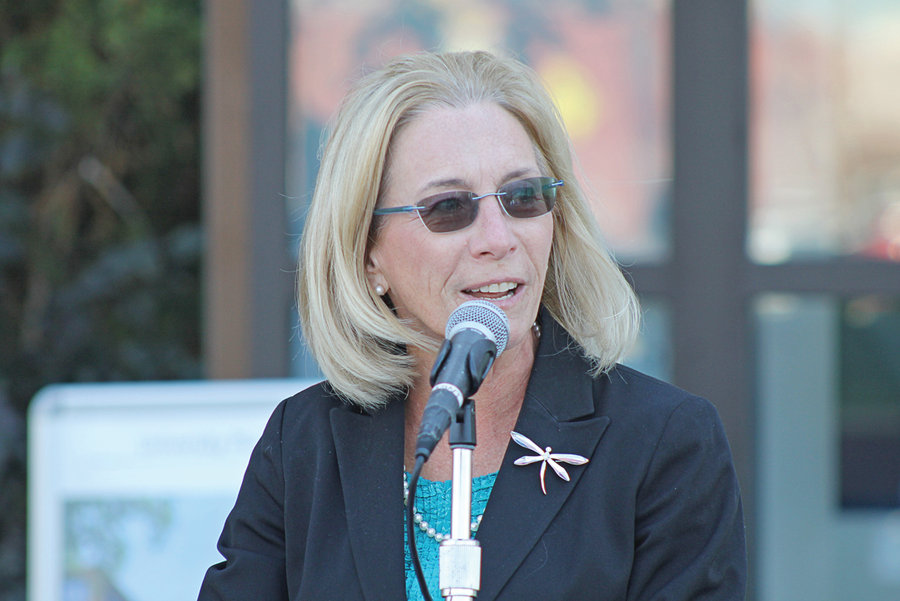The cool wind blowing off the Hackensack River on Sept. 12 knocked down placards and stirred up dust over the largely barren landscape along Jersey City’s West Side Avenue. Devoid of buildings for the moment, the property is destined to become the western campus of New Jersey City University (NJCU) as well as a new residential and retail development that will fill in one more piece in what city officials hope will become a new Gold Coast in Hudson County.
For this reason, a host of dignitaries, better dressed for the board room than a construction site, gathered to celebrate the joint venture between the Hampshire Companies and Claremont Companies along with their project investment advisory, Circle Squared Alternative Investments, to break ground on the first phase of a master redevelopment plan.
Two months ago, the City Council voted to approve two ordinances that gave NJCU 30-year tax abatements that made the project possible.
School and city officials lobbied the state legislature to allow public/private ventures such as this, said Council President Rolando Lavarro.
That resulted in a change of state law allowing the city to give payments in lieu of taxes (PILOTS) to private developers working with colleges, even though colleges like NJCU are tax-exempt entities, officials said. This is a tradeoff to state colleges, whose state aid has been shrinking over the last decade. The abatements make it possible to offset some of the costs of construction.
“This will transform the west side of Jersey City.” Bill O’Dea
____________
Located between West Side Avenue and Route 440, this property is near the Honeywell redevelopment area.
Dubbed University Place, the developers hopes to create a neighborhood that will have ties to the university, serving as possible residences for faulty and others with some connection to the educational component.
“This project will transform NJCU’s west campus into a modern urban community with expanded access to retail and local amenities,” said Norman Feinstein, vice chairman of the Hampshire Companies, saying that Jersey City is evolving into a place where people can live, work, play, and learn. “University Place is an integral part of the continued evolution of the city.”
Increased growth has caused increased need
Susan Henderson, president of NJCU, said the inspiration for west campus started under her predecessor, but bloomed under her watch. She said increased student population has created a clear need for expansion, and she predicted that with the continued growth, the need would be even greater.
“We want to grow beyond Hudson County,” she said.
Freeholder Bill O’Dea, who represents that section of the city but is also involved in economic development, was part of the discussions for the project since its inception.
“This, along with the Honeywell and other development projects, will transform the west side of Jersey City,” O’Dea said.
The construction companies have also agreed to use union labor, and the city will receive about $2 million a year in payments in lieu of taxes.
Last year, the school broke ground on the $350 million development by starting construction of a new 425-bed undergraduate residence hall, which officials also cut the ribbon on at the same Sept. 12 ceremony.
The ground breaking begins the first of two mixed use projects that hopes to create 163 market rate units and about 10,000 square feet of retail space along West Side Avenue.
The project is also expected to include a ShopRite grocery store, an LA Fitness Center, and a restaurant as additional phases kick in.
The project has already received some tax relief from the state Economic Development Authority, but the abatements would help make the private development possible.
NJCU is leasing 21 acres to private developers for about 50 years and the revenue from those leases will pay the mortgage on a performance art building with two theaters, 16 practice rooms, classrooms and a dance space.
This phase of the project is expected to be ready for occupancy at some point in 2017.
Not far from other city centers
The site is located within a third of a mile from the existing West Side Avenue station of the Hudson Bergen Light Rail, allowing residents here to access New York City, Hoboken, and elsewhere. On-site and street parking will also be added near the corner of Stegman Boulevard and West Side Avenue.
The first phase will include the construction of 177 structured parking spaces, two bike terminals, and 25,000 square feet of indoor and outdoor amenity space.
The luxury rentals will consist of 27 studio apartments, 112 one-bedroom and 24 two-bedroom units ranging from 550 square feet to 1,300 square feet.
“This transformative project will offer all of the luxury and lifestyle amenities of comparable waterfront/downtown properties at affordable price points,” said Richard Sciaretta, director for Claremont Companies.
The university hopes to generate enough funding from the agreements with the private developers to fund the construction of a future performing arts center. Included in the current project, however, is a public plaza which will be open to the public but maintained by the university. This will host a number of public and university events including concerts, a farmers market, cultural activities, and graduations.
The master redevelopment plan consists of eight buildings including a 100,000 square food performing arts center/academic building.
Al Sullivan may be reached at asullivan@hudsonreporter.com.
